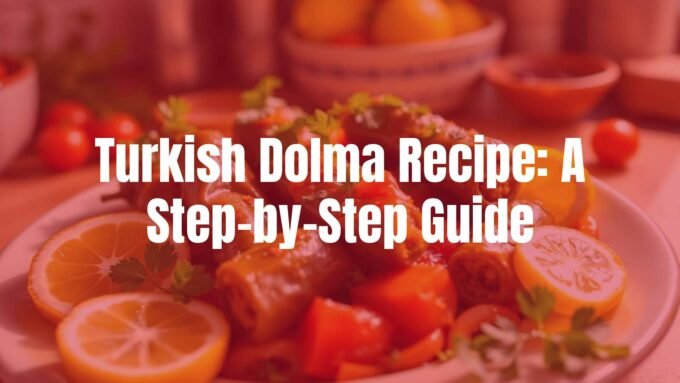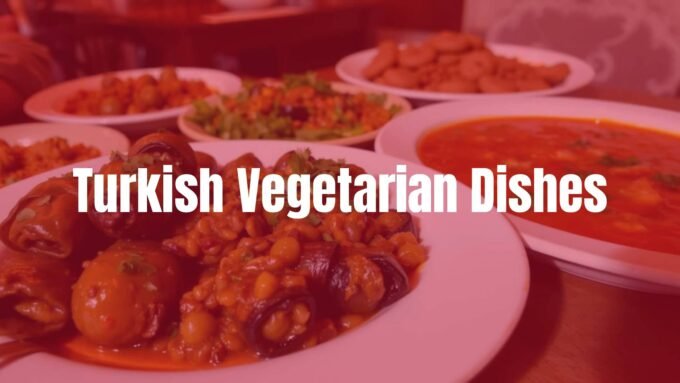Turkish meze recipes are a great way to explore the flavors of Turkish and Mediterranean cooking. But what are Turkish meze recipes, exactly? Put simply, they are a collection of small, tasty dishes meant for sharing. They’re similar to Spanish tapas or classic appetizers in other countries. Meze dishes can be eaten before the main course, or, if you prepare enough of them, they can make up the whole meal. Sharing meze brings people together and makes eating a fun, social activity full of different tastes and textures.
One of the best things about Turkish meze is the variety and the fresh ingredients used. Meze can be creamy dips, colorful salads, crispy fritters, or stuffed vegetables. Each dish gives you a piece of Turkey’s long food tradition. Whether you want just a few light bites before dinner or a full table for friends and family, learning about Turkish meze opens up many tasty options.
What are Turkish meze recipes?
Turkish meze is more than just a set of dishes-it’s a big part of how people in Turkey eat together. Each small plate is meant to be shared. The experience is slow and relaxed, letting you talk and enjoy being together. Meze makes meals longer, encourages chatting, and celebrates Turkish hospitality-whether at a restaurant or at home with family.

Meze is very flexible. Often, it’s served before the main meal, but with enough variety, meze can easily be the main meal too-especially with a glass of traditional Turkish raki. With so many different meze, everyone can find something they enjoy, whether they prefer vegetables, meat, or seafood-all full of the bright flavors Turkey is known for.
Main traits of meze
The main point of meze is variety and freshness, all meant for sharing. Usually, all the dishes are served at once, covering the table with bright colors and inviting smells. Fresh, seasonal food is used, and most recipes are simple, letting the main ingredients stand out. On a meze table, you’ll find both cold and hot dishes, and a mix of textures.
Meze portions are small, so you can try many dishes without feeling too full. In Turkey, there’s a saying: “Az az ortaya,” meaning “little by little in the middle”-enjoying little tastes of many different things instead of one big meal. Eating meze is meant to be unhurried and social, turning the meal into a long, enjoyable event.
History and importance
The roots of meze go back to the Ottoman Empire, which covered a lot of the Eastern Mediterranean and Middle East. Over time, meze adapted to local ingredients everywhere people lived in the empire. In Turkey, meze became an important food tradition and a key part of eating together.
Meze also stands for togetherness in Turkish culture. For Turkish people, eating is about more than food-it’s about connecting with others. Whether in a busy tavern (meyhane) or a quiet home, meze helps everyone slow down and enjoy time together. It’s a sign of the warm welcome Turkish hosts give to guests.
What ingredients are used in Turkish meze?
Great Turkish meze always start with fresh, simple ingredients commonly found in the Mediterranean. Even though recipes differ by region or season, some basic foods appear again and again. These staple ingredients are chosen for their taste and because they go well together, giving you balanced, delicious plates.
If you know the basics, you’re halfway to making perfect Turkish meze. These ingredients add bright colors, lovely smells, and a mix of textures. From the golden olive oil to the tangy yogurt and strong fresh herbs, every part helps give Turkish meze its special flavor.
Pantry basics
| Ingredient | Example Use |
|---|---|
| Olive oil | Cooking, dressings, dips |
| Bulgur wheat | Kısır (bulgur salad) |
| Chickpeas, white beans | Hummus, piyaz |
| Bread (pide, simit) | Scooping dips, side for salads |
A well-prepped Turkish kitchen always has these basics on hand. Bread is especially important at every meze table, perfect for dipping and picking up all the delicious sauces and juices.
Fresh produce and herbs
Fresh vegetables make Turkish meze taste so good. Common veggies include tomatoes, cucumbers, and peppers-key for salads and spreads like ezme. Eggplant is also very popular, used in many meze platters, from cold salads to cooked dishes.
Liberal use of herbs is another trademark. Parsley, mint, dill, and cilantro give dishes a bright taste and a burst of green. Using lots of fresh produce and herbs means meze is not only good-tasting but also healthy.

Dairy: cheese and yogurt
Dairy, especially cheese and yogurt, is a must for many Turkish meze. Turkish yogurt is thicker and tangier than Western versions, so it’s perfect for creamy dips like haydari and cacık. Feta cheese, especially the kind made from sheep’s milk, brings a tangy and salty quality, delicious in salads and spreads like girit ezmesi.
Spices and extras
Spices are key in Turkish meze, bringing out their taste without heavy heat. Common spices include cumin, pul biber (mild Turkish red pepper flakes, like Aleppo pepper), and sumac, which is sour and lemony. Pomegranate molasses (nar ekşisi) is another key ingredient, adding a unique sweet-sour taste.
| Spice/Condiment | Flavor | Typical Dish |
|---|---|---|
| Sumac | Tangy, lemony | Salads, ezme |
| Pul biber | Mild, warm | Ezme, kısır |
| Pomegranate molasses | Sweet & sour | Kısır, muhammara |
Types of Turkish meze
Turkish meze comes in many forms, with different flavors, textures, and ways of cooking. From cool, light salads to comforting beans and hearty meat plates, there is a meze for everyone. That’s what makes a meze platter so exciting-there’s always something to try and to mix together. Here are some of the main types:
Vegetable meze
- Şakşuka: Roasted eggplant, tomato, and pepper salad, served cold
- Patlıcan Salatası: Smoky eggplant salad, often on bread
- Fresh salads: Tomato, cucumber, and feta; carrot salad with yogurt (Havuç Salatası)
These dishes showcase fresh, seasonal veggies, often simply prepared, and are both tasty and healthy.
Legume and grain meze
- Kısır: Bulgur wheat salad with pomegranate molasses, herbs, and mild spice
- Piyaz: White bean salad (Antalya style has tahini dressing)
- Hummus: Sometimes topped with hot meats in Turkey
These recipes are filling, rich in protein, and add substance to your spread without being too heavy.
Fish and seafood meze
- Midye Dolma: Mussels stuffed with herbed rice, pine nuts, and currants
- Karides Güveç: Baked shrimp with cheese
- Deniz börülcesi: Samphire (sea vegetable) salad with lemon and garlic
Seafood meze are especially loved on the coast, bringing a touch of the sea to the table.
Meat and chicken meze
- Koftes: Small seasoned meatballs or patties in tomato-pepper sauce
- Çerkez Tavuğu: Shredded chicken with walnut sauce
- Oruk/Icli Kofte: Bulgur shells filled with a mixture of walnuts and ground meat
These add some richness to the meal and show the depth of Turkish flavors.
Dairy meze, dips, and spreads
- Haydari: Yogurt, garlic, and fresh herbs dip
- Cacık: Yogurt and cucumber dip, served cold and refreshing
- Girit Ezmesi: Feta cheese and pistachio spread
- Muhammara: Red pepper and walnut dip with pomegranate molasses
- Havuç Tarator: Carrot and yogurt dip
Dips and spreads like these are perfect for bread and veggies, adding creamy, tangy, or slightly spicy layers of taste.

How to make Turkish meze at home
Bringing Turkish meze into your kitchen is fun and not as complicated as it might seem. Most meze are easy to make and many can be prepared a day or two ahead. Using fresh ingredients and simple cooking is key to getting that true Turkish taste. With some advance planning, you can put together a full Turkish meze meal for friends or family.
Basic steps for making meze
- Pick a good mix of recipes (choose dips, fresh salads, and one or two warm dishes).
- Prep your veggies and herbs first, so cooking goes faster.
- Make dips and cold salads first-these get better after chilling a bit.
- Prepare warm dishes just before serving, so they stay fresh and tasty.
- Taste everything as you go, adjusting lemon, oil, and spices to what you like.
Tools you’ll need
- A sharp knife for chopping herbs and veggies
- Mini food processor for smooth dips (hand chopping works too)
- Mixing bowls, small spatulas, and serving dishes
- Grater for carrots or cheese
- For frying, a deep-fry thermometer helps, but isn’t required
Tips for real Turkish taste
- Use the freshest tomatoes, olive oil, and herbs you can find.
- Sumac and pul biber (Aleppo pepper) are essentials for that special Turkish flavor.
- Pomegranate molasses brings sweet-tart taste-worth finding if possible.
- Let prepared dishes rest in the fridge to let the flavors develop (at least 30 minutes before serving).
Popular Turkish meze recipes
Now, let’s look at some classic Turkish meze that are loved at any table. These dishes show how diverse and delicious Turkish food can be-and they’re easy to try, even for beginners. Make them for a weeknight treat or a special get-together-you’ll enjoy a taste of Turkey no matter where you are.
| Meze Dish | Main Ingredients | Notes |
|---|---|---|
| Haydari | Strained yogurt, garlic, fresh herbs | Creamy, refreshing dip, great with bread or veggies |
| Kısır | Bulgur, tomato, cucumber, parsley, pomegranate molasses | Zesty bulgur salad, slightly spicy |
| Cacık | Yogurt, cucumber, mint, dill, garlic | Light, cooling dip or soup, similar to tzatziki |
| Ezme | Tomato, peppers, onion, olive oil, lemon, spices (sumac, pul biber) | Spicy, tangy crushed salad or dip |
| Şakşuka | Eggplant, peppers, tomato, garlic, olive oil | Served cold, full of rich veggie flavor |
| Mücver | Zucchini, dill, parsley, eggs, flour | Crispy fritters, served with garlicky yogurt |
| Sarma | Grape leaves, rice, fresh herbs, often pine nuts and currants | Stuffed and rolled, sometimes with ground meat |
| Barbunya Pilaki | Borlotti beans, tomatoes, onion, garlic, carrots, olive oil | Cooked in olive oil, served cool or at room temperature |
| Girit Ezmesi | Feta cheese, pistachios, olive oil, fresh herbs | Spread for bread-salty and a bit sweet |
How to serve and enjoy Turkish meze
Eating Turkish meze is about more than just food-it’s about sharing. Meze is served in a casual, welcoming style, usually with lots of dishes in the center of the table. Everyone helps themselves, taking small bites, chatting, and enjoying the time together.
Serving the meze
- Place all the small plates in the middle of the table.
- Provide plenty of bread like pide or simit for dipping and scooping.
- Let guests take what they want, encouraging sampling and mixing flavors.
Pairing with drinks and mains
- Bread is always served, and it’s the base for scooping dips and salads.
- Raki, a Turkish anise drink, is a classic choice with meze-especially with seafood. Ayran (a salty yogurt drink) and Turkish tea are good non-alcoholic options.
- Meze can be served before main dishes like grilled kebabs, or on busy tables, the meze itself is the main event.
Tips for a meze gathering at home
- Prepare cold dishes ahead of time; these taste better after resting in the fridge.
- Make a mix: dips, salads, maybe 1-2 warm or more filling dishes.
- Offer plenty of fresh bread.
- Let everyone help themselves, have music, and enjoy the relaxed pace.

Turkish meze FAQ
Turkish meze can be new to some people, so here are answers to common questions to help you make and enjoy these small dishes at home.
What makes something a meze?
Any small sharing plate can be a meze-what matters is that it’s served as part of a group of dishes, meant for everyone at the table. Meze is about variety and togetherness, not a single big course.
Are meze served hot or cold?
Meze includes both hot and cold options. Most yogurt dips, salads, and bean dishes are served cold, made ahead of time. Some recipes-like fried fritters or stuffed pastries-are best served hot or warm, right before eating. A good meze spread will have both cold and hot plates.
Are Turkish meze suitable for vegetarians or vegans?
Yes! Many classic meze dishes are vegetarian or vegan, focusing on veggies, grains, and olive oil. Examples include kısır, ezme, şakşuka, barunya pilaki, and hummus. Even dips made with yogurt can sometimes be adapted using plant yogurts. With so much variety, everyone can find something they enjoy at a Turkish meze table.
















Leave a comment